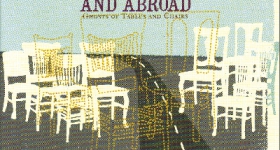Three Years and Eight Months
introduces young readers to the Japanese occupation of Hong Kong during World
War II through the eyes of Choi, a young boy who sees his family torn apart by
war. Early in the book, Choi finds his mother being dragged away from their
home by a Japanese soldier. Uncle Kim pulls him aside and explains that Japan
has attacked Pearl Harbor and is now taking Hong Kong. As three years and eight
months of devastation and prolonged separation from friends and family drag on,
Choi’s young life is changed.
Smith has both a difficult and
important job to address: how does one talk about the complexities of war to a
young audience? As a storyteller, Smith brings readers into Choi’s shoes by
describing his emotions and his observations. Smith provides very simple
sentences in creating this very accessible historical narrative for
elementary readers. Three Years represents
an important dialogue among generations, and while its tone is serious, readers
of all ages will rejoice in Choi’s hope, perseverance and strength.
The illustrator, Jennifer
Kindert, has created dramatic urban and rural landscape scenes showing the
difficulties of life in occupied Hong Kong. Her illustrations and color choices
of muted grays, blues, and greens compliment the tone of the story. Her illustrations
of facial expressions that show grief, sadness, exhaustion and at the end,
relief and happiness, are quite moving. Amongst the muted cool colors, the red
sun of the Japanese flag pierces through each image as a reminder of the Japanese
military’s power. While every other page in the book depicts a significant
scene, Kindert inserts into the text of the story itself smaller illustrations
of key mementos in Choi’s path that deepen the storytelling.
Throughout the story, we sense
Choi’s loneliness. He forms a close friendship with another boy named Taylor who has also
been separated from his mother. During the war, Choi and Taylor deliver
packages for Japanese soldiers in exchange for food. They also sneak medical supplies
to Uncle Kim who distributes the goods to an underground resistance group.
When Hiroshima is bombed by the
United States and the war ends, Choi quickly moves to find his mother, but her
freedom is met with a very uncertain future as compared to the experiences of
other women: “[W]hen we arrive at Mom’s building, we see hundreds of women
leaving. Many of them have lost their families and homes during the war. Many
feel shame for socializing with Japanese soldiers and end up becoming Buddhist
nuns.”
In the book’s epilogue entitled
“Remembering History,” the following passage sticks out to me most: “The
Japanese army looted homes, burned villages, and assaulted and killed thousands
of civilians. To celebrate their victory, the Japanese soldiers were given
implicit permission for three days to rob, rape and kill anyone in Hong Kong.” While
very saddened by these words, I also wondered as to what Smith’s intentions
were in including these details right after the story. We learned that Choi’s
mother was “treated badly," but is Smith making a more grisly connection? I
applaud Smith’s efforts for bringing the story of Three Years to young audiences, but without a disclaimer or
suggestion to parents prior to the epilogue, I wonder what young readers might
think when diving into this history on their own.
After reading this book, I reflected
on my childhood conversations with my parents about this time in history. Gratefully,
my parents very willingly spoke with me about the history of World War II in
Asia, what happened to women during the war (a topic I knew a lot about at a
young age thanks to my Korean mother), and the current affairs still impacted
by the war. It was a tough conversation then, and it still is now. I work with
young audiences often, sharing the tragedies and triumphs of Seattle’s Asian
Pacific American community. On occasion, my colleagues and I receive feedback
from parents or teachers who wish we had not talked about the incarceration of
Japanese Americans or the Khmer Rouge in Cambodia due to the potential emotional
difficulty it can create. While my colleagues and I do closely consider the
ages of the audiences attending, we still strive to share the stories and
experiences of so many people who have survived and now live in our communities
today. All stories, even stories of war, can be shared with many ages on
varying levels. It’s a very fine balance in choosing between which details to
share, how to share them, and which messages to emphasize, but we must remember
that in order for us to better understand our present and work towards a more
hopeful future, we must always listen to the past.
Andrea Kim Taylor lives in Seattle and works in the city’s
Chinatown-International District.









Comments